Advantages of a Concrete Slab Foundation
Slab foundations are less complex than other forms, which means lower construction costs and maintenance requirements for homes or buildings with them.
Builders typically install all internal plumbing, gas and water lines prior to pouring concrete. This enables them to reach these pipes should any repairs need to be performed on them.
Structural Strength
Concrete house slabs Melbourne foundations offer numerous benefits. First and foremost, they’re much cheaper to construct and require minimal upkeep compared to other forms of foundations. Furthermore, there’s less chance for moisture damage or radon gas leakage because there’s no space under your house where moisture could collect.
They’re especially popular in warmer climates because the ground doesn’t freeze and cause damage. Before buying a home with a concrete slab foundation, it is crucial that buyers inspect for moisture issues and potential problems, in order to get these repaired before they worsen. Construction processes for such foundations tend to be fast and straightforward allowing builders to work faster while saving time; footings are filled with concrete then allowed to cure before the slab is poured on top.
Mold and Termite Resistance
Slab foundations may become susceptible to moisture issues when there is improper soil drainage or an elevated groundwater table, and if left unaddressed these issues could lead to mold and mildew forming under the home and damage its framing structure.
Concrete slabs may be treated with disodium octoate-tetrahydrate or borate to guard them against termites; this must be completed prior to installing siding and sheetrock.
One drawback of a slab foundation is accessing sewer and water lines when needing repair or replacement services, which may require you to jackhammer through concrete to reach them – something wood foundations do not necessitate for repairs and replacements.
Ease of Access
If you are planning on building on a slab foundation, it is wise to first prepare the site. Clear away shrubbery, underbrush, stumps and large rocks which could rot into the soil over time and lead to sinkholes.
Slab foundations work best in temperate and mild climates where frost heave isn’t an issue, though they might not be ideal in areas with rocky soil or extreme temperature changes.
Slab houses differ from basement or crawl space homes by being closer to the ground, making them easier for those with limited mobility to access. Furthermore, these types of houses also boast more consistent indoor temperatures while needing less maintenance than their counterparts; still it is essential that one keeps an eye out for pests that could enter through any cracks in walls.
Energy Efficiency
Soil-on-slab foundations don’t typically offer as much insulation as crawl spaces or basements, leading to increased energy bills in your home.
One disadvantage of a slab foundation is the difficulty in accessing its plumbing pipes in case of problems; this requires jackhammering to reach them, unlike in crawl space or basement environments where accessing them would be simpler.
In order to address this problem, builders will often add a stem wall before pouring a slab. To do this, they first create a concrete form around the perimeter of their footprint before adding reinforcement and filling it up with concrete – this helps protect from frost or other environmental effects from damaging it further.
Cost
Slab foundations tend to cost less than other foundation types due to fewer steps involved in their construction process.
Un rooom space makes it harder to access water and gas lines for repair or upgrade purposes, which leads to an increase in repair costs over time.
Slab foundations may also be susceptible to moisture if soil drainage is poor, leading to mold growth and ultimately damaging concrete in their foundation.
Due to this reason, it’s wise to add a 2-inch layer of styrofoam underslab insulation in order to help keep concrete dry and prevent moisture damage to structures. Although adding this step adds approximately $0.50-$2 per square foot in costs, long term it could save money through reduced energy costs and damage caused by moisture damage.
